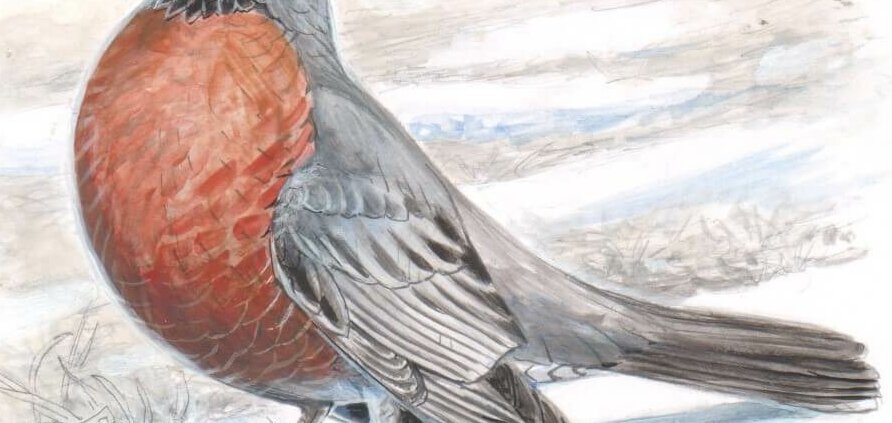Robins Everywhere
Story and illustration by Doug Pifer
Each morning during mid-February, robin songs echo from the woods behind the barn. Flocks of them stream overhead. Dozens of robins fly back and forth between the sycamores and the banks of the creek. On sunny afternoons robins forage in scattered groups in the mowed field across the road. In the evenings they gather in the cedar trees to roost.
Almost everyone recognizes an American robin. They lay their turquoise blue eggs in grass-lined mud nests in backyard shade trees, hunt worms to feed their speckle-bellied babies, and scold us if we venture too close to their nests. Say “bird” to any American and I’ll bet most of them would
visualize a robin.
Despite its familiarity, we have much to learn about the American robin. Its scientific name means “migratory thrush,” yet its movements after the nesting season can hardly be described as migratory. Robins breed throughout the continental United States and across southern Canada. Most Canadian birds move southward sometime in the fall, and the U.S. population tends to greatly increase in the southern states during the winter months. But in much of its range, you might see a robin any time of the year.
Much about the travels of robins remains unknown. Scientists often trap wild birds and release them with GPS transmitters attached to their backs to study their movements. Robins have proved difficult to get data from, not because they’re hard to catch in mist nets, but because it’s difficult to re-capture the same robin a year or so later. Robins lack the nest site fidelity many other birds have. They may return to the same general area the following year, but not to the same place where they nested before.
Robins have soft bills that aren’t made for cracking and eating seeds. During the nesting season, robins, and the young they are feeding, consume a high protein diet, mostly worms and insects. Then as fall approaches they turn to eating fruits and berries.
A fruit diet makes robins go where food is plentiful. In early fall, robins congregate where wild grapes festoon the edges of waterways, or along woodland edges where dogwood, sassafras, and honeysuckle grow. Later they glean dropped and unpicked orchard fruit. Then in December, after several prolonged freezes, groups of robins may appear in suburban landscaped parking lots where they find Callender (Bradford ) pear, holly, and other ornamental fruit bearing trees. Or they frequent certain woods where persimmon, hackberry, holly, and cedar trees bear fruit. A great part of their winter diet consists of the berry-like blue fruits of red cedar trees.
This year I’ve noticed many of our local cedar trees are unusually fruitful. Many cedar boughs are packed with so many “berries” they look blue from a distance. Red cedar groves also provide cover where robins can roost in great numbers, protected from the elements. The birds can hide there with less chance of being taken by predatory owls
and hawks.
Meanwhile flocks of restless, excited robins continue to brighten the landscape. No matter why they’re here, they can stay as long as they like. Their chorus at sunrise announces with absolute certainty that spring isn’t just around the corner—it’s already here.










